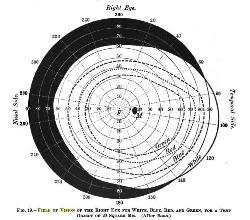At an idle moment recently, I was wondering what shape my field of vision has. A quick Google search took me to Alexander Duane’s and Ernst Fuchs’s 1899 textbook of ophthalmology, which is online. I am sure there is much more recent work–both empirical and conceptual–but I didn’t explore it. Instead, I began to speculate that this is a fairly complicated question.

But my retinas are three-dimensional, as is the world they see. So should we say that my field of vision is a section of an ovoid with some irregularities created by my nose, eyebrows, and hair? Even that that answer seems oversimplified, since my eyeballs are capable of focusing at different depths (and even rolling around, although that might be forbidden in a test of one’s field of vision); and the world itself is not pasted on the inside of an oval–it extends into the distance. If we said that the shape of my field of vision was roughly ovoid, how big would that ovoid be? The night sky that is sometimes part of it is awfully far away. And I haven’t even mentioned that we see moving things and bright colors more easily than stable, dull things. By now, it’s beginning to sound as if my field of vision has no shape. But surely that can’t be right; my vision has limits and moves as I change my orientation. We’ve begun talking about the world, not what I see of it.
By the way, it is interesting how easily we accept a photograph as a representation of vision, even though it is flat and rectangular, whereas our field of vision is–at the very least–irregular and vaguely bordered.
Wittgenstein seems to want us to dispense with the goal of analogizing inner experience to something else, as if everyday experience required some explanation on terms other than its own:
- And above all do not say ‘After all my visual impression isn’t the drawing; it is this–which I can’t shew to anyone.’–Of course it is not the drawing, but neither is it anything else of the same category, which I carry within myself. … If you put the ‘organization’ of a visual impression on a level with colours and shapes, you are proceeding from the idea of the visual impression as an inner object. Of course this makes this object into a chimera; a queerly shifting construction. For the similarity to a picture is now impaired. — Philosophical Investigations, translated by Anscombe, IIxi.
For Wittgenstein, I take it, a field of vision has no shape, and we only feel that that’s strange because we are in the grip of a model of vision as inner photography. It’s actually something else entirely. And yet I keep returning to my initial thought that what I see is an oval with my nose intruding from the bottom.